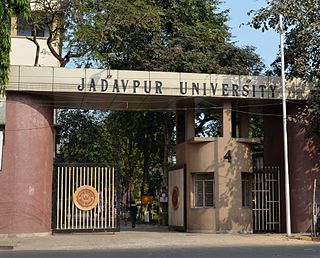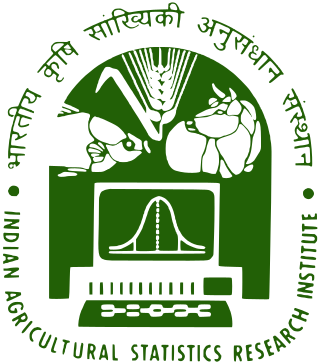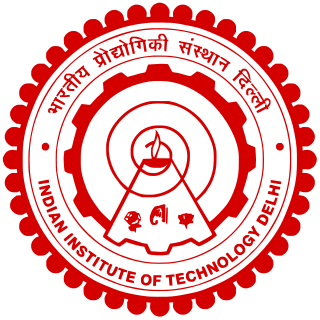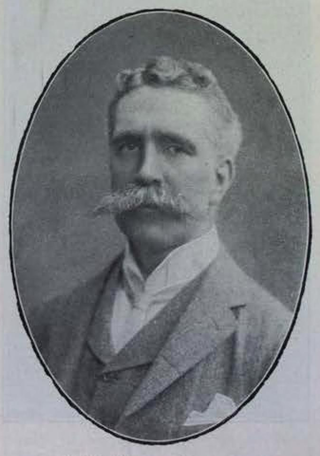
Jadavpur University is a public state university with its main campus located in Jadavpur, Kolkata, West Bengal, India. It was established in 1906 as Bengal Technical Institute and was converted into Jadavpur University in 1955. As of 2023 NIRF rankings, Jadavpur University has been ranked 4th among universities, 10th among engineering institutes, and 13th overall in India.

The Gandhigram Rural University (GRI) is a centrally-funded Deemed University based on Dindigul in Tamil Nadu, India.

The University of Calcutta is a public state university located in Kolkata, West Bengal, India. It has 151 affiliated undergraduate colleges and 16 institutes in Kolkata and nearby areas. It was established on 24 January 1857 and is the oldest multidisciplinary university of Indian Subcontinent and South East Asian Region. Today, the university's jurisdiction is limited to a few districts of West Bengal, but at the time of its establishment it had a catchment area ranging from Kabul to Myanmar. Within India, it is recognized as a "Five-Star University" and accredited an "A" grade by the National Assessment and Accreditation Council (NAAC).

The Indian Agricultural Statistics Research Institute is an institute under the Indian Council of Agricultural Research (ICAR) with the mandate for developing new techniques for the design of agricultural experiments as well as to analyze data in agriculture. The institute is affiliated with and is located in the campus of the Indian Agricultural Research Institute, a deemed university, at Pusa in New Delhi. The institute includes sections that specialize in statistical techniques for animal and plant breeding, bioinformatics, sampling, experimental design, modelling and forecasting.
Pusa is a genus of earless seal.

Panjab University (PU) is an Indian collegiate public state university located in Chandigarh. Funded through both State and Union governments, it is considered a state university. It traces its origins to the University of the Punjab in Lahore, which was founded in 1882. After the partition of India, the university was established on 1 October 1947, and called East Punjab University. Initially housed primarily at a cantonment in Solan, it later relocated to a newly built campus in Chandigarh, and was renamed Panjab University. It is accredited by NAAC at five star level, with the highest NAAC A++ accreditation grade.

University Grants Commission is a statutory body under Department of Higher Education, Ministry of Education, Government of India. It was set up in accordance to the UGC Act 1956 and is charged with coordination, determination and maintenance of standards of higher education in India. It provides recognition to universities in India, and disbursements of funds to such recognized universities and colleges. The UGC headquarters are in New Delhi, and it has six regional centres in Pune, Bhopal, Kolkata, Hyderabad, Guwahati and Bangalore. A proposal to replace it with another new regulatory body called HECI is under consideration by the Government of India. The UGC provides doctoral scholarships to all those who clear JRF in the National Eligibility Test. On an average, each year ₹725 crore (US$91 million) is spent on doctoral and post-doctoral fellowships by the commission.

Guru Gobind Singh Indraprastha University, formerly Indraprastha University, is a state university located in Dwarka, Delhi, India. The campus occupies 78 acres, among the largest in Delhi, and enrolls over 8,000 students.

SRM Institute of Science and Technology (SRMIST), formerly SRM University, is a private deemed university, located in Kattankulathur, Chengalpattu, Tamil Nadu, India. Founded in 1985 as SRM Engineering College in Kattankulathur, it gained the deemed status in 2002. SRM Institute of Science and Technology includes six campuses, four in Tamil Nadu — Kattankulathur, Ramapuram and Vadapalani, and Tiruchirappalli, one in Amaravati, Andhra Pradesh and one in NCR Delhi.

The Gujarat University is a public state university located at Ahmedabad, Gujarat, India. The university is an affiliating university at the under-graduate level and a teaching university at the post graduate level. It is accredited B++ by NAAC. It was established on 23 November 1949.

Tata Institute of Social Sciences (TISS) is a multi-campus public university in Mumbai, India. It is Asia's oldest institute for professional social work education and was founded in 1936 in the then Bombay Presidency of British India as the Sir Dorabji Tata Graduate School of Social Work by the Sir Dorabji Tata Trust. In 1944, the institute was officially renamed the Tata Institute of Social Sciences and in 1964, the Government of India declared TISS a deemed university under Section 3 of the University Grants Commission Act (UGC), 1956.

Dr. Rajendra Prasad Central Agricultural University, formerly known as Rajendra Agricultural University, is a public central agriculture university under the Department of Agricultural Research and Education of Ministry of Agriculture and Farmers Welfare and is recognised as Institute of National Importance by government of India. It is located in Pusa, Samastipur district, Bihar.

IIT Delhi, officially the Indian Institute of Technology Delhi, is a public institute of technology located in Delhi, India. It is one of the 23 Indian Institutes of Technology created to be Centre of Excellence for India's training, research and development in science, engineering and technology.

Lovely Professional University (LPU) is a private university located in Chaheru, Phagwara, Punjab, India. The university was established in 2005 by Lovely International Trust, through the Lovely Professional University Act, 2005 and started operation in 2006.

India has a publicly funded higher education system that is the third largest in the world. The main governing body at the tertiary level is the University Grants Commission, which enforces its standards, advises the government, and helps coordinate between the centre and the state. Accreditation for higher learning is overseen by 15 autonomous institutions established by the University Grants Commission (UGC).

Benjamin Peary Pal or B. P. Pal FRS was an Indian plant breeder and agronomist who served as a director of the Indian Agricultural Research Institute in Delhi and as the first Director General of the Indian Council of Agricultural Research. He worked on wheat genetics and breeding but was also known for his interest in rose varieties.
Ebrahimali Abubacker Siddiq is an Indian agricultural scientist, whose research in genetics and plant breeding is reported to have assisted in the development of various high-yielding rice varieties such as dwarf basmati and hybrid rice. The government of India honoured Siddiq in 2011 with the fourth-highest civilian award of Padma Shri.

Vijaipal Singh in Narsan Kalan, Haridwar District of Uttarakhand State, India is an Agricultural scientist associated with the Indian Council of Agricultural Research (ICAR) and is known for his contributions to the science of rice genetics and breeding. He is well known for his contributions in developing the most popular Basmati rice variety, Pusa Basmati 1121. A post graduate and a doctoral degree (PhD) holder in Agriculture Botany from Agra University, he started his career as a research assistant at the Indian Agricultural Research Institute (IARI), New Delhi in 1968 and retired as a professor at the Division of Genetics, IARI. Singh is credited with several articles published in peer reviewed journals. In recognition of his services to the nation, he was honored by the Government of India, in 2012, with the fourth highest Indian civilian award of Padma Shri.

John Walter Leather was an agricultural chemist who worked in India as the first Imperial Agricultural Chemist at the Imperial Agricultural Research Institute in Pusa, Bihar. Appointed in 1892, he worked on a variety of agricultural production and chemistry related issues in India.
Pusa Road is an arterial road and one of the major roads of New Delhi, India. Several prominent educational institutions and hospitals are located on the road. The neighbourhoods of Karol Bagh and Rajendra Nagar are respectively on the northern and southern sides of the road. It forms part of the Patel Road - Pusa Road - Link Road corridor that connects West Delhi to Connaught Place. This is one of the busiest arterial routes in the city; according to a 2014 estimate, it carries 170,000 vehicles per day.



















